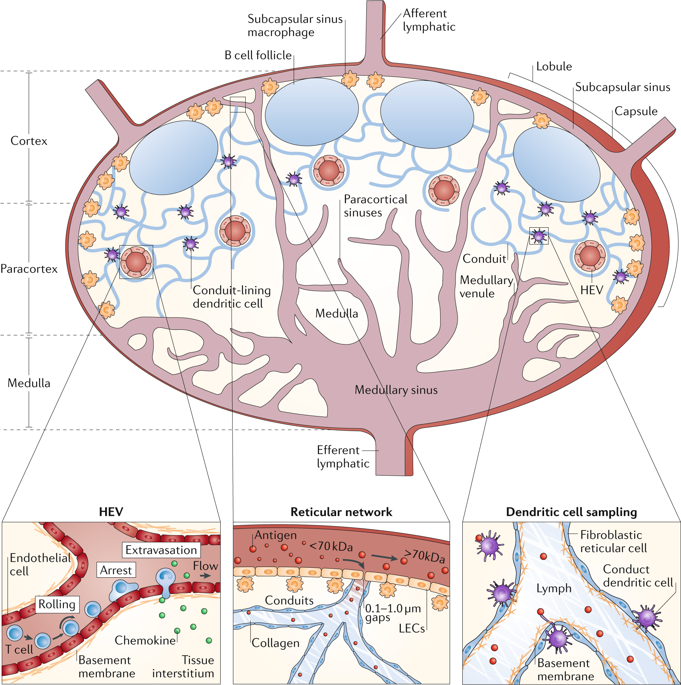Nature Reviews Materials ( IF 79.8 ) Pub Date : 2019-05-02 , DOI: 10.1038/s41578-019-0110-7 Alex Schudel 1, 2, 3 , David M Francis 2, 3, 4 , Susan N Thomas 2, 5, 6, 7

|
A significant fraction of the total immune cells in the body are located in several hundred lymph nodes, in which lymphocyte accumulation, activation and proliferation are organized. Therefore, targeting lymph nodes provides the possibility to directly deliver drugs to lymphocytes and lymph node-resident cells and thus to modify the adaptive immune response. However, owing to the structure and anatomy of lymph nodes, as well as the distinct localization and migration of the different cell types within the lymph node, it is difficult to access specific cell populations by delivering free drugs. Materials can be used as instructive delivery vehicles to achieve accumulation of drugs in the lymph nodes and to target specific lymph node-resident cell subtypes. In this Review, we describe the compartmental architecture of lymph nodes and the cell and fluid transport mechanisms to and from lymph nodes. We discuss the different entry routes into lymph nodes and how they can be explored for drug delivery, including the lymphatics, blood capillaries, high endothelial venules, cell-mediated pathways, homing of circulating lymphocytes and direct lymph node injection. We examine different nanoscale and microscale materials for the targeting of specific immune cells and highlight their potential for the treatment of immune dysfunction and for cancer immunotherapy. Finally, we give an outlook to the field, exploring how lymph node targeting can be improved by the use of materials.
中文翻译:

淋巴结药物输送的材料设计。
人体中总免疫细胞的很大一部分位于数百个淋巴结中,其中淋巴细胞的积累,活化和增殖被组织起来。因此,靶向淋巴结提供了将药物直接递送至淋巴细胞和淋巴结驻留细胞的可能性,从而改变了适应性免疫应答。然而,由于淋巴结的结构和解剖,以及淋巴结内不同细胞类型的独特定位和迁移,很难通过递送游离药物来进入特定的细胞群。这些材料可用作指导性运载工具,以实现药物在淋巴结中的蓄积并靶向特定的淋巴结驻留细胞亚型。在这篇评论中,我们描述了淋巴结的隔室结构,以及淋巴结之间的细胞和液体运输机制。我们讨论了进入淋巴结的不同进入途径,以及如何探索它们的药物传递途径,包括淋巴管,毛细血管,高内皮小静脉,细胞介导的通路,循环淋巴细胞的归巢和直接淋巴结注射。我们研究了针对特定免疫细胞的不同纳米级和微米级材料,并强调了它们在治疗免疫功能障碍和癌症免疫疗法中的潜力。最后,我们对该领域进行了展望,探讨了如何通过使用材料来改善淋巴结靶向性。包括淋巴管,毛细血管,高内皮小静脉,细胞介导的通路,循环淋巴细胞的归巢和直接淋巴结注射。我们研究了针对特定免疫细胞的不同纳米级和微米级材料,并强调了它们在治疗免疫功能障碍和癌症免疫疗法中的潜力。最后,我们对该领域进行了展望,探讨了如何通过使用材料来改善淋巴结靶向性。包括淋巴管,毛细血管,高内皮小静脉,细胞介导的通路,循环淋巴细胞的归巢和直接淋巴结注射。我们研究了针对特定免疫细胞的不同纳米级和微米级材料,并强调了它们在治疗免疫功能障碍和癌症免疫疗法中的潜力。最后,我们对该领域进行了展望,探讨了如何通过使用材料来改善淋巴结靶向性。









































 京公网安备 11010802027423号
京公网安备 11010802027423号